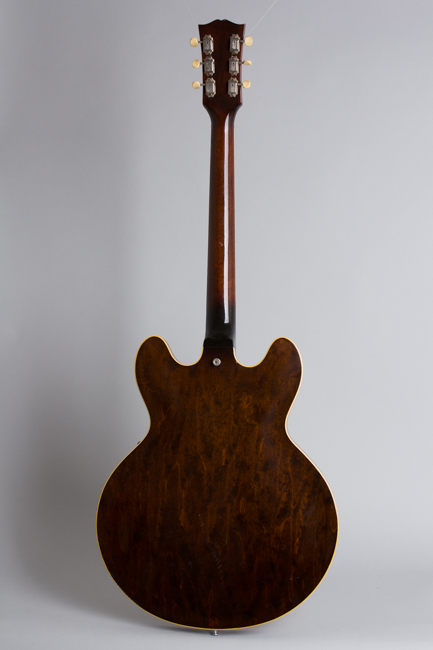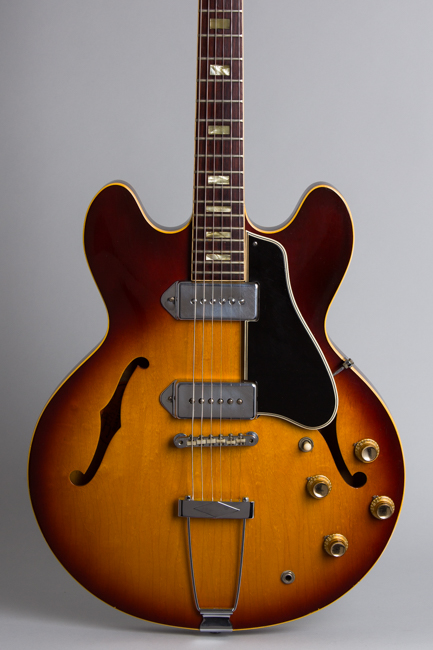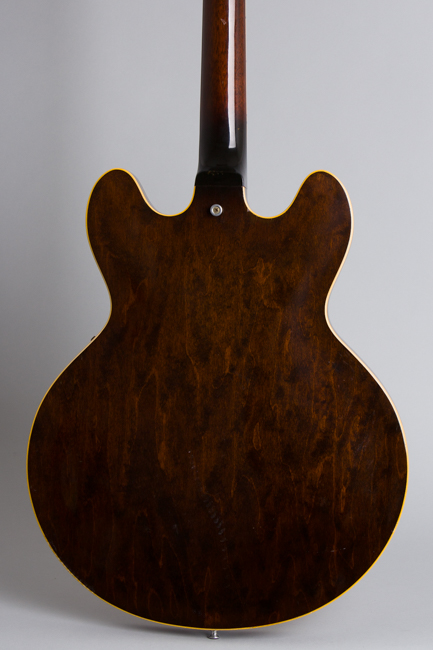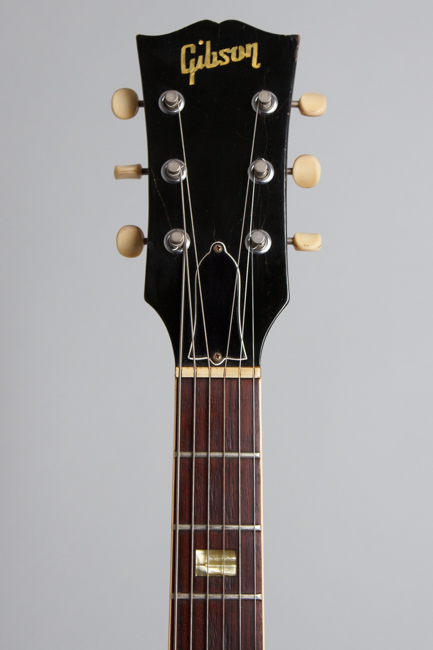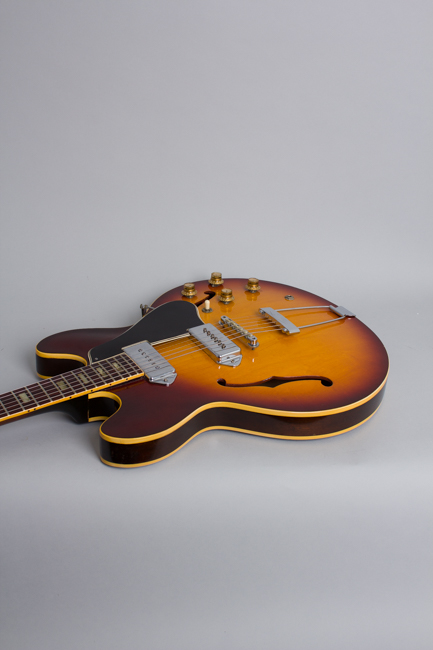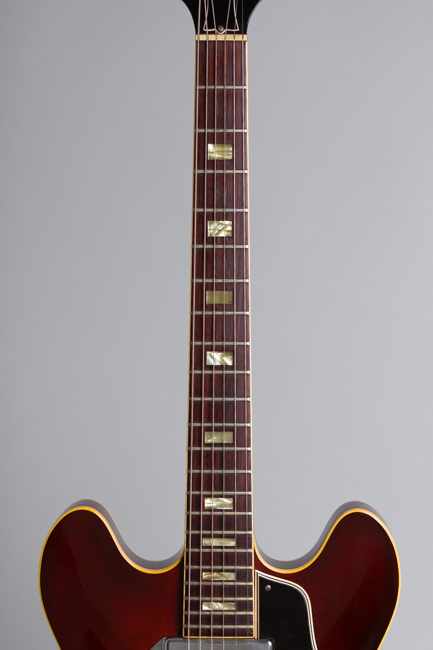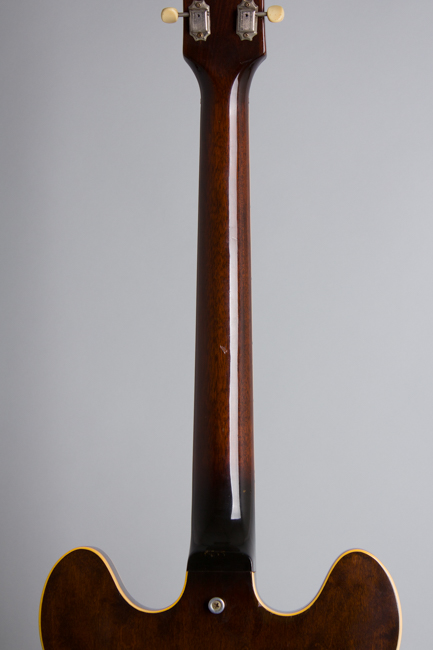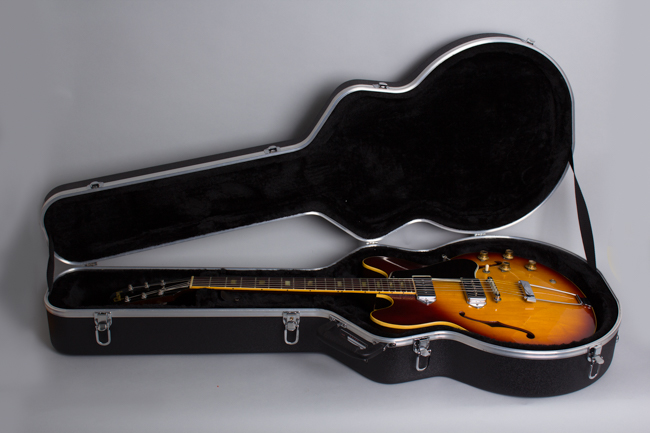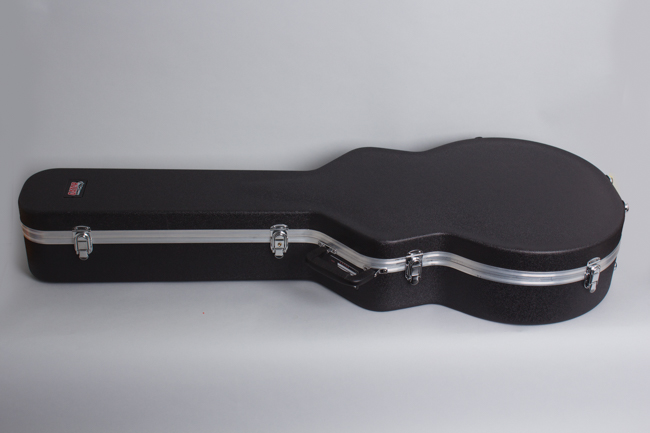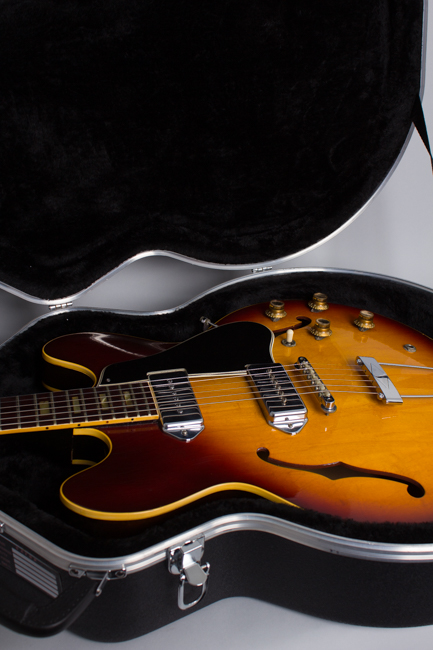Gibson ES-330TD Thinline Hollow Body Electric Guitar (1966)
This item has been sold.
Item # 12151
Prices subject to change without notice.
Gibson ES-330TD Model Thinline Hollow Body Electric Guitar (1966), made in Kalamazoo, Michigan, serial # 822552, sunburst top, dark back and sides finish, laminated maple body, mahogany neck with rosewood fingerboard, black gig bag case.
This is a super nice original example of a sunburst ES-330 from 1966, a year that codified many detail changes to the instruments from the earlier '60s. This 330 has typical appointments for the year; all hardware including the pickup covers, tailpiece and tune-o-matic bridge with nylon saddles are chrome plated. The nut is the very narrow 1 1/2" width often seen this year, although 1 5/8" was the technically correct standard. Exactly 2000 sunburst ES-330 TD's shipped from Kalamazoo in 1966, the instrument's largest total so far. While not particularly rare these were still not built in the same quantities as some models even at the height of the guitar boom.
The single bound body has a medium brown-yellow sunburst finish on the top only and is fully hollow, unlike the semi-hollow 335-355 series. The neck joins the body at the 16th fret and has a bound rosewood fingerboard with pearloid block inlay. The tuners are single enclosed Kluson Deluxe with plastic buttons. The two P-90 pickups are mated to the standard Gibson wiring rig, with the older 60's style "capped" gold plastic tone and volume knobs and white switch tip. This ES-330TD has an orange label under the bass side F-hole mounted upside down, a curiosity but not unheard of in this busty year at Kalamazoo!
The ES-330TD is a great sounding and very versatile guitar at home in many musical situations. Despite being intended by Gibson as an "amateur" instrument (the least expensive of the double-cutaway thinlines) the 330 has been used by legions of professional players and heard on countless classic records in many styles since its introduction in 1959. Jazz great Grant Green used this model extensively on his most well-regarded early-1960's recordings. A number of period bluesmen have been spotted with it as well, including B.B. King, Chuck Berry and most notably Slim Harpo, who is nearly always pictured with one.
The 330 and its nearly identical sister guitar the Epiphone Casino were featured in countless '60's British invasion groups, including the Beatles, Rolling Stones, Kinks, Manfred Mann, the Merseybeats and many more. The American garage band era players who took inspiration from these bands made extensive use of the model as well. This early 1966 guitar shows only very minor wear and is a superb period example, with the expected "Fab" sound and excellent playability in spades!
Overall length is 40 1/2 in. (102.9 cm.), 16 in. (40.6 cm.) wide at lower bout, and 1 3/4 in. (4.4 cm.) in depth, measured at side of rim. Scale length is 24 3/4 in. (629 mm.). Width of nut is 1 1/2 in. (38 mm.).
This guitar is in very well preserved original condition overall, looking not too much played and well cared for over the past 58 years. The original finish and hardware are intact and complete. The lacquer is clean overall with some typical checking (most heavily on the headstock, oddly) but not much fade; the top retains very strong color to the sunburst. There are some minor dings and chips overall but no heavy wear; one of the front upper corners of the headstock is very slightly chipped. The most notable wear is several spots of "Curly Cord Burn" to the back, where one must have left in contact with the lacquer for some time.
The plating on the pickups, tailpiece and bridge is quite clean. There is an old Gibson strap button at the heel probably added, as it is farther back than most. The frets are original and have been crowned down a bit; there is some minor divoting in the lower positions but nothing that affects playability. Overall this is a great example and a friendly player, especially if you enjoy a narrow neck. It resides in a modern molded plastic case. Overall Excellent Condition.
This is a super nice original example of a sunburst ES-330 from 1966, a year that codified many detail changes to the instruments from the earlier '60s. This 330 has typical appointments for the year; all hardware including the pickup covers, tailpiece and tune-o-matic bridge with nylon saddles are chrome plated. The nut is the very narrow 1 1/2" width often seen this year, although 1 5/8" was the technically correct standard. Exactly 2000 sunburst ES-330 TD's shipped from Kalamazoo in 1966, the instrument's largest total so far. While not particularly rare these were still not built in the same quantities as some models even at the height of the guitar boom.
The single bound body has a medium brown-yellow sunburst finish on the top only and is fully hollow, unlike the semi-hollow 335-355 series. The neck joins the body at the 16th fret and has a bound rosewood fingerboard with pearloid block inlay. The tuners are single enclosed Kluson Deluxe with plastic buttons. The two P-90 pickups are mated to the standard Gibson wiring rig, with the older 60's style "capped" gold plastic tone and volume knobs and white switch tip. This ES-330TD has an orange label under the bass side F-hole mounted upside down, a curiosity but not unheard of in this busty year at Kalamazoo!
The ES-330TD is a great sounding and very versatile guitar at home in many musical situations. Despite being intended by Gibson as an "amateur" instrument (the least expensive of the double-cutaway thinlines) the 330 has been used by legions of professional players and heard on countless classic records in many styles since its introduction in 1959. Jazz great Grant Green used this model extensively on his most well-regarded early-1960's recordings. A number of period bluesmen have been spotted with it as well, including B.B. King, Chuck Berry and most notably Slim Harpo, who is nearly always pictured with one.
The 330 and its nearly identical sister guitar the Epiphone Casino were featured in countless '60's British invasion groups, including the Beatles, Rolling Stones, Kinks, Manfred Mann, the Merseybeats and many more. The American garage band era players who took inspiration from these bands made extensive use of the model as well. This early 1966 guitar shows only very minor wear and is a superb period example, with the expected "Fab" sound and excellent playability in spades!
Overall length is 40 1/2 in. (102.9 cm.), 16 in. (40.6 cm.) wide at lower bout, and 1 3/4 in. (4.4 cm.) in depth, measured at side of rim. Scale length is 24 3/4 in. (629 mm.). Width of nut is 1 1/2 in. (38 mm.).
This guitar is in very well preserved original condition overall, looking not too much played and well cared for over the past 58 years. The original finish and hardware are intact and complete. The lacquer is clean overall with some typical checking (most heavily on the headstock, oddly) but not much fade; the top retains very strong color to the sunburst. There are some minor dings and chips overall but no heavy wear; one of the front upper corners of the headstock is very slightly chipped. The most notable wear is several spots of "Curly Cord Burn" to the back, where one must have left in contact with the lacquer for some time.
The plating on the pickups, tailpiece and bridge is quite clean. There is an old Gibson strap button at the heel probably added, as it is farther back than most. The frets are original and have been crowned down a bit; there is some minor divoting in the lower positions but nothing that affects playability. Overall this is a great example and a friendly player, especially if you enjoy a narrow neck. It resides in a modern molded plastic case. Overall Excellent Condition.


